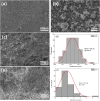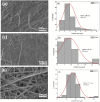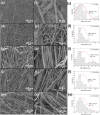Electrospun fibers of zein and pea protein to create high-quality fibrous structures in meat analogs
- PMID: 39530060
- PMCID: PMC11551025
- DOI: 10.3389/fbioe.2024.1483966
Electrospun fibers of zein and pea protein to create high-quality fibrous structures in meat analogs
Abstract
Introduction: The importance of developing plant-based meat similar to animal meat lies in the fact that sensory similarity is a crucial factor in encouraging consumers to adopt this alternative.
Methodology: The present study reports the morphology, hydrophilicity, and thermal analysis of different fibers obtained by the electrospinning method. In the first step of this work, zein and zein/poly(ethylene oxide) (PEO) in 80% aqueous ethanol solution with varying concentrations of these polymers were investigated.
Results and discussion: It was observed that the diameters of the electrospun fibers are related to the concentration and viscosity of the solutions. Moreover, the addition of small percentages of PEO makes the fibers more hydrophilic and leads to an increase in the polymeric solution viscosity. Because of its low toxicity, PEO is used in various edible products. In the second step of this work, an ideal zein/PEO combination was found to allow the pea protein (PP) to be electrospun. Adding PP to the zein/PEO blend (20:1) leads to a more hydrophilic fiber and improves thermal stability. The results suggest that the zein/PEO and zein/PEO/PP blends can offer an innovative solution to enhance the texture and appearance of plant-based meats. These simulated electrospun fibers can mimic the fibers in animal meat and are a potential alternative to provide a sensory experience as close to animal meat as possible.
Keywords: electrospinning; fibers; innovative food; plant protein; plant-based.
Copyright © 2024 da Trindade, Zanchet, Bonsanto and Braga.
Conflict of interest statement
The authors declare that the research was conducted in the absence of any commercial or financial relationships that could be construed as a potential conflict of interest.
Figures










References
-
- Ali S., Khatri Z., Oh K. W., Kim I.-S., Kim S. H. (2014). Zein/cellulose acetate hybrid nanofibers: electrospinning and characterization. Macromol. Res. 22, 971–977. 10.1007/s13233-014-2136-4 - DOI
-
- Dekkers B. L., Boom R. M., van der Goot A. J. (2018). Structuring processes for meat analogues. Trends Food Sci. Technol. 81, 25–36. 10.1016/j.tifs.2018.08.011 - DOI
-
- Dekkers B. L., Nikiforidis C. V., van der Goot A. J. (2016). Shear-induced fibrous structure formation from a pectin/SPI blend. Innovative Food Sci. and Emerg. Technol. 36, 193–200. 10.1016/j.ifset.2016.07.003 - DOI
-
- Fong H., Chun I., Reneker D. H. (1999). Beaded nanofibers formed during electrospinning. Polym. Guildf. 40, 4585–4592. 10.1016/S0032-3861(99)00068-3 - DOI
LinkOut - more resources
Full Text Sources
Miscellaneous

